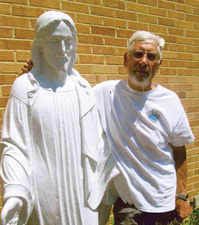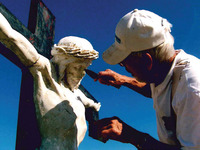Roger Huntley is a man blessed with many talents. Born in Yankton, South Dakota, he is the oldest of Henry and Edna’s six children. It was while working alongside his father that Roger began to learn the trade of plastering. At the young age of eleven years old, he would carry heavy buckets of concrete and sand, which he would then mix with water by hand to make plaster. Roger shares, “My arms are probably three inches longer than my brothers, from carrying all those buckets during those growing years. I was so happy when my dad got an electric mixer!”
After his marriage to his beloved wife of sixty-two years; Marilyn, Roger continued to learn his trade and moved swiftly along from novice, to apprentice, to journeyman and ultimately to his final status as a master plasterer. Besides owning his private business, Roger shared his love of the work with many at risk young adults, during his fifteen years teaching as a vocational instructor and ten years more, as a coordinator for the South Dakota Job Corps.
Throughout their marriage, Roger and Marilyn have enjoyed travelling all over the world and have made many life-long friends. An early example of this occurred in 1958, shortly after the couple were married and Roger was drafted into the Army. He was stationed near the Black Forest at a relay station. Marilyn flew to Germany to be close to Roger and lived with the Kaufhold family, in the nearby town of Schomberg. The young couple celebrated the birth of their first child;
Kimberly, while living overseas and the families grew extremely close. Even after their return to the United States, the Huntley’s have repeatedly visited their friends over the years. Members of the Kaufhold family have also come on multiple trips to America to see Roger and Marilyn as well. During one of their visits in the early 1990’s, the Kaufholds brought over a beautiful, traditional beer stein as a gift. Roger and Marilyn wanted to give something appropriate to South Dakota’s rich history, for their next trip back to Germany in return.
The European friends were very interested in Native American culture, so the Huntley’s thought a peace pipe would make a wonderful gift. When the couple went to various places in the South Dakota and Minnesota looking for pipes, Roger wasn’t impressed with the craftsmanship for the price, and thought some might have even been made overseas. Roger has always been a self-taught artist. He had a natural affinity for whittling since childhood, and has always enjoyed carving objects out chunks of found wood. It was natural for him to quickly come to the conclusion that, “Well, I can do better than this!” Soon the couple were researching how the traditional pipes were made. They learned that sumac and ash trees were the wood of choice for the plains Indians. They used the soft wood for the elongated stem of the pipes, and red catlinite from Pipestone, Minnesota was used for the mouth piece and bowl. Roger shares that through his research he “has gained an immense respect for the Native American pipe makers, as their only tools were what was found in nature.”
Roger brought fifty pounds of catlinite from a very old quarry in Minnesota and carefully chosen wood home himself. He learned how to burn an airway into the deepest core of the wood, and fashion the bowls. In addition, he decorated the pipes, and made each unique by carving different animals into the stems, such as snakes, coyotes, lizards, bears, and other traditional wildlife. Marilyn requested a wolf for the peace pipe the couple keep on their fireplace mantle for themselves. It has always been important to Roger to make them as authentic as possible. As Roger’s skill making pipes progressed, he expanded into doing other types of three dimensional carving in various types of woods.
The couple also started doing presentations for the Beadle School first graders to celebrate Native American Day in 2005. This began when their grandchildren, Ethan and Hanna were students there and has continued ever since. In addition to their annual visits at Beadle School, the Huntleys added the Human Services Center this year. The children are always eager to learn about Native American culture and are fascinated by Roger’s peace pipes and artwork.
After making many peace pipes for family and friends, Roger was asked to do a presentation for the Yankton Connecting Artists club at the G.A.R Hall in 2008. It was at this show that Roger found a pivotal friend and mentor in Scott Luken. Luken attended the show and was very impressed by Roger’s work. Roger recalls, “We hit it off right away and got along super well. He thought I could do more than just pipes.” It was Luken who gave Roger his first piece of alabaster accompanied with a challenge, “Let’s see what you can do with this.” Luken offered the use of his studio and tools to Roger. It was this first opportunity with continuing technical assistance and guidance, that inspired Roger’s future art development and work with limestone, granite, and honeycomb calcite. Roger credits Luken for being instrumental in his work with rock sculpture. It wasn’t until 2013 that Roger had the opportunity to attend his first formal stone sculpting class in Lawrence, Kansas.
The Huntleys soon began an ongoing membership with the Yankton Area Arts and Roger with the Connecting Artists club in Yankton, as well. Roger soon began creating larger sculptures. Six of these have been selected and featured during the years Yankton had its downtown and Riverside Park RiverWalk outdoor tour exhibits from 2010-2016. Three of these were made into
bronzed replicas and three are made of weather resistant, limestone. The piece titled “Pipe Maker” was intentionally created as “A tribute to honor previous generations of talented and hardworking pipe makers.” It was voted for the 2011 People’s Choice award. It is now on permanent display, located just outside the entrance of the Meridian Bridge in Yankton. Another sculpture titled “The Captives” which was also featured in the 2015/2016 RiverWalk is currently on display in downtown Norfolk, and will remain there until the spring of 2020.
Roger usually has multiple pieces he’s working on simultaneously. Even after making over one hundred peace pipes he still enjoys the process and continues to make more. Currently he’s working on some smaller limestone swans and a much larger buffalo piece. Time quickly passes for Roger when he becomes immersed in his art work, if it weren’t for Marilyn to remind him to break, he might not eat for hours. The Huntleys have also been very involved with the local Mead building project that has now become the home of the Dakota Territorial Museum/Mead Cultural Education Center. Roger has spent many hours the last few years doing restoration work inside the Mead Building as well as inside the State Capital Building in Pierre, and the historic County Courthouse in Deadwood, South Dakota in 2007. He has brought sadly deteriorated statues of Jesus back to their original splendor at Trinity Lutheran Church, and the Catholic Cemetery in Yankton.
In addition to his personal projects, travelling, and spending time with family and friends, Roger also enjoys flying his joint owned Cessna 172 and is very proud of the work he’s done over the years with the Yankton Aviation Association where he’s served as past president, and the Young Eagles Program which provides school age children with free airplane rides. Roger has given well over 200 of these exciting aviation experiences to local children. In July 2017, Roger received the rare Wright Brothers “Master of Aviation” award from the Department of Transportation Federal Aviation Administration for fifty hours of documented dedicated service in aviation safety. He jokingly asks, “Did you know that I’m a UFO?” He then pulls out an embroidered ball cap with an emblem that explains that it stands for United Flying Octogenarians.
When asked about future ideas for possible stone work, Roger says he’s got an idea in mind which involves incorporating a family into a sculpture. Roger’s art has always had a story behind it, and he often sees images hidden within the rough contours of stone or wood that are invisible almost to everyone else. It’s almost as if his natural material has been patiently waiting for him to come along to free it and bring it to life for others to appreciate in another form.




